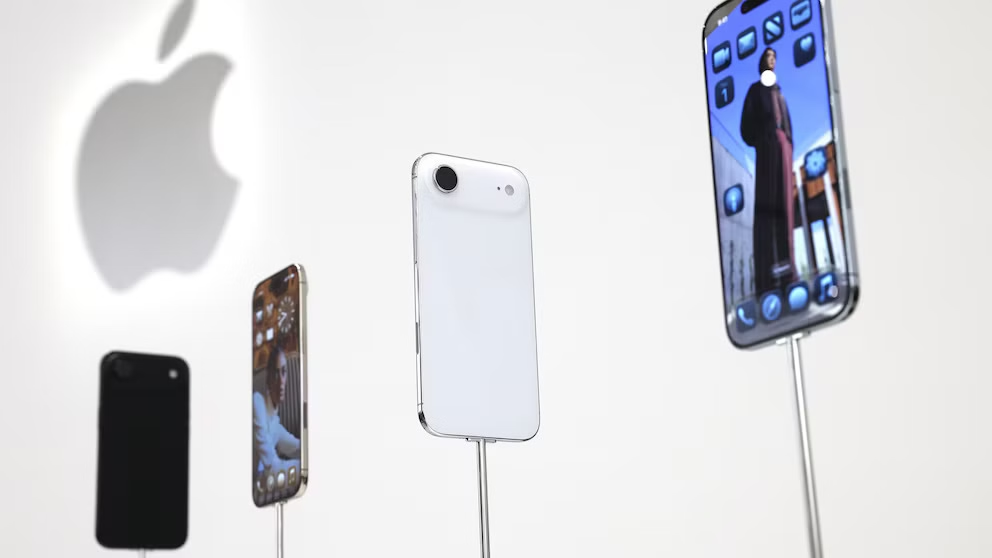Apple has unveiled its latest innovation — the iPhone Air, the thinnest iPhone ever, measuring just 5.6 mm in thickness. As part of the expanded iPhone 17 lineup, the Air model offers pro-level performance wrapped in an impossibly slim and light design. Balancing aesthetics and power, the device reflects Apple’s continued push toward sleek portability without sacrificing functionality.
Design Breakthrough: Beauty Meets Strength
Ultra-Slim and Durable
The iPhone Air sets a new benchmark in smartphone design. At 5.6 mm thick and weighing just 165 grams, it is the slimmest and lightest iPhone yet. With its Grade-5 titanium frame— including 80 percent recycled titanium— the phone achieves both thinness and structural strength.
Display Innovation
Equipped with a 6.5-inch Super Retina XDR display, the iPhone Air delivers a vibrant visual experience with ProMotion up to 120 Hz and peak brightness up to 3,000 nits. The screen maintains pop and clarity even under bright lighting.
Internal Efficiency
Apple’s design prioritizes internal layout. Many critical components are stacked in a raised “plateau” within the body, maximizing space for a surprisingly large battery in such a slim frame.
Power Performance: Small Package, Big Punch
A19 Pro Chip and Connectivity
Under the hood, the iPhone Air packs an A19 Pro chip, delivering a performance leap over its predecessors. Communication and connectivity are handled by Apple’s in-house C1X modem and N1 networking chip, bringing Wi-Fi 7, Bluetooth 6, and Thread support.
Battery Life Surprises?
Despite its slender design, Apple promises up to 27 hours of video playback, with up to 40 hours when paired with the optional MagSafe battery accessory. Rumors hint that Apple may have turned to silicon-carbon battery technology to enable this slim profile, though real-world performance and durability remain to be seen.
Camera Capabilities: Simplified, Yet Smart
Rear and Front Imaging
The iPhone Air features a 48 MP Fusion Main camera — a refined single-lens system that delivers high-resolution shots through integrated imaging technology. The front-facing camera utilizes 18 MP Center Stage, letting users take dynamic selfies that reframe automatically and even record front and rear videos simultaneously.
Quality Over Quantity
While the Air omits multi-lens arrays such as ultra-wide or telephoto, Apple emphasizes that the Fusion system aims to provide rich detail and versatility within a minimalist design.
Price, Availability, and Market Context
Pricing and Preorders
The iPhone Air starts at $999 for the base 256GB model in the United States. Preorders begin September 12, with full availability starting September 19, 2025.
Positioned Within the iPhone 17 Lineup
Joining the iPhone 17, iPhone 17 Pro, and iPhone 17 Pro Max, the iPhone Air replaces the previous “Plus” models. Apple frames it as a “MacBook Air-inspired” entry into its smartphone family — thin, light, yet powerful.
Analysis: Pros, Trade-Offs, and Strategic Direction
Design vs. Feature Trade-Offs
The ultra-slim design makes the iPhone Air an appealing choice for those valuing portability. However, the reliance on a single rear camera and concerns about battery longevity—especially given the limited internal volume—may limit its appeal for power users and photography enthusiasts.
Strategic Refocus
By introducing the Air model, Apple broadens its design philosophy. Following in the MacBook Air’s footsteps, the phone embodies a premium, minimalist identity. At the same time, the continued use of Pro-class silicon and advanced connectivity ensures it doesn’t feel like a stripped-down variant.
Conclusion and Future Outlook
The iPhone Air stands as Apple’s slimmest phone yet, balancing thin design with robust capabilities. Looking forward, its success may influence future innovations — perhaps even foldable devices — by proving that slimness need not come at the cost of performance.
As the market adjusts to this new offering, key indicators will include customer feedback on battery life, camera experience, and adoption rates compared to traditional models. Apple’s direction with the Air hints at a design-first future — one that values elegance, innovation, and refined performance in equal measure.
Also Read More: DRAP Recalls Anarob Antibiotic Drip

